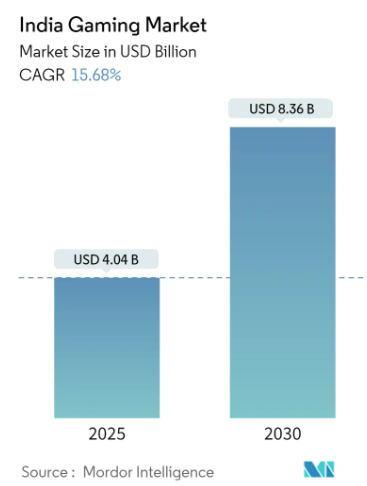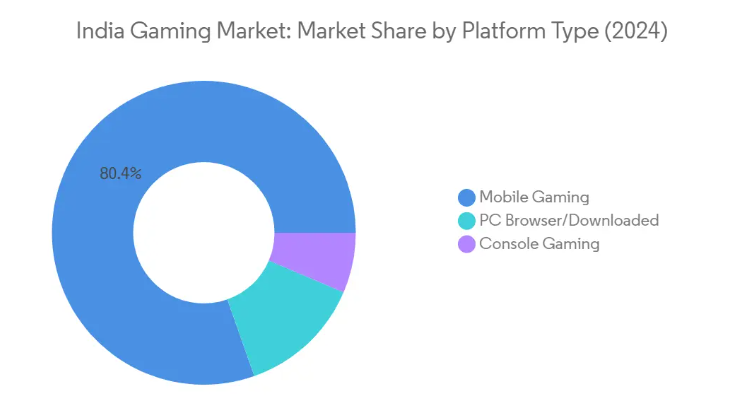The Gaming Industry In India :
A Market on the Rise

-Ishan Singh
Investment Analyst
India’s gaming industry is undergoing a rapid transformation, driven by a tech-savvy population, widespread smartphone adoption, and increasing internet penetration. With an estimated market size of USD 4.04 billion in 2025, projected to reach USD 8.36 billion by 2030 at a CAGR of 15.68%, the sector is poised for exponential growth.

Key Drivers of Growth in the Indian Gaming Industry
1. Internet and Smartphone Penetration
India’s affordable data costs (USD 0.26 per GB) have fueled the gaming boom, making mobile gaming the dominant segment. With 46% of the population engaged in online gaming, rising smartphone adoption in tier 2 and tier 3 cities continues to drive industry expansion.
2. Web3 and Metaverse Integration
India is a Web3 gaming leader, with 30% of its 450 Web3 businesses focused on gaming. Investments exceeding USD 400 million in VR, AR, and metaverse applications are creating immersive experiences, attracting both gamers and developers.
3. Government Support and Regulation
The government is actively shaping the gaming sector:
Inter-Ministerial Task Force (IMTF) is drafting national gaming regulations.
Group of Ministers (GoM) is formulating structured tax policies.
Market Trends Shaping the Future of Gaming in India
1. Growing Youth Population and Gaming Engagement
With one of the largest youth populations in the world, India offers a massive consumer base for gaming. The younger generation’s digital literacy and interest in premium gaming experiences have led to a shift from freemium models to paid gaming applications.
Developers are now focusing on India-centric gaming content, catering to local preferences and cultural narratives.
2. Investment and Infrastructure Development
The gaming industry has witnessed substantial investments from both domestic and international players:
5,283 Indian game publishers contribute to the global gaming ecosystem, representing 3% of all Google Play publishers.
The rollout of 5G technology is expected to revolutionize cloud gaming, AR games, and competitive online gaming experiences.
Companies like Samsung are investing in local smartphone manufacturing (USD 40 billion production plans), ensuring a steady supply of high-performance gaming devices.
3. Emergence of India’s Local Game Development Ecosystem
Indian game developers are now creating original intellectual properties (IPs), competing with global giants. Titles like Ludo King and locally developed battle royale games have gained immense popularity.
The rise of gaming startups and development studios highlights India’s potential as a game development hub, backed by a skilled workforce and technological innovation.
Segment-Wise Analysis of the Indian Gaming Market
1. Mobile Gaming: The Market Leader
Mobile gaming commands 80% of India’s gaming market in 2024, driven by:
Affordable smartphones and data plans
Over 200 game development companies actively creating local IPs
Increased foreign investments in mobile game development
A surge in casual, battle royale, and esports-based mobile games
2. PC and Console Gaming: A Growing Market
While mobile gaming dominates, the PC and console gaming segments are also witnessing growth:
PC gaming is gaining traction due to high-performance gaming laptops from brands like Dell, Lenovo, and ASUS.
Esports tournaments and competitive gaming are driving PC gaming adoption.
Console gaming, though a niche market, continues to attract hardcore gaming enthusiasts, with brands like Sony (PlayStation) and Microsoft (Xbox) leading the way.

India’s Gaming Industry: Competitive Landscape and Innovation
1. Top Companies in the Indian Gaming Market
India’s gaming market includes a mix of global gaming giants and homegrown developers, such as:
Microsoft, Sony, and Nintendo competing in the premium gaming space.
Indian developers like Nazara Technologies, Gametion Technologies (Ludo King) and Rolocule Games driving localized game development.
Strategic partnerships between international publishers and Indian studios, leveraging market expertise for customized content.
2. Localized Content and Cloud Gaming
To stay competitive, gaming companies are:
Investing in localized, India-specific gaming experiences.
Exploring cloud gaming and subscription-based models for greater accessibility.
Balancing affordability with premium experiences, catering to a diverse consumer base.
3. Esports and Competitive Gaming on the Rise
Esports is a fast-growing sector in India, with increasing viewership and sponsorships. Platforms like BGMI, Valorant, and Call of Duty: Mobile are leading the competitive gaming wave.
India’s esports ecosystem is witnessing:
More professional teams and tournaments.
Increased investments in esports organizations.
Government-backed initiatives supporting esports as a legitimate industry.
Insights from Industry Engagement
Our firm recently had the opportunity to engage with the management of a leading gaming company in India. This interaction provided us with in-depth knowledge and clarity on the company’s strategic initiatives and the broader industry’s trajectory. The management emphasized their commitment to innovation, user engagement, and expanding their portfolio to cater to diverse gaming preferences.
Strategic Initiatives
The company has undertaken several strategic initiatives to solidify its position in the market:
Diversification: Expanding into various gaming genres to attract a wider audience.
Acquisitions: Acquiring stakes in emerging gaming firms to enhance capabilities and market reach.
Technological Integration: Investing in cutting-edge technologies to improve user experience and stay ahead of industry trends.
The Path Forward
The insights gained from our engagement underscore the dynamic nature of India’s gaming industry. Companies are not only focusing on scaling operations but also on creating sustainable and inclusive growth models. The emphasis on innovation, strategic partnerships, and user-centric approaches is expected to drive the industry forward.
Conclusion
India’s gaming industry stands at a pivotal juncture, poised for exponential growth. With favourable demographics, technological advancements, and strategic industry initiatives, the sector is set to redefine entertainment in the country. As stakeholders, it is imperative to stay informed and engaged with these developments to harness the opportunities that lie ahead.

